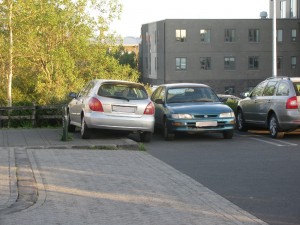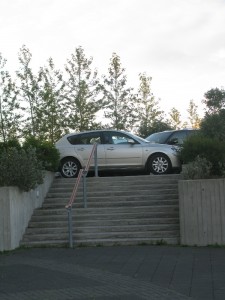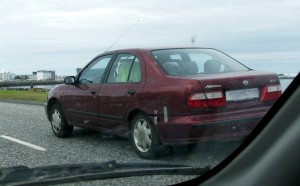These roads were not always here. Posted by hulda on Aug 23, 2012 in Icelandic culture, Icelandic customs, Icelandic history
 When looking at the map of Iceland there’s one unusual thing that easily catches the eye: there don’t seem to be many, if any, roads in the middle of the country. Most of them go around Iceland along the main road called Þjóðvegur 1 or Hringvegurinn (= Ring Road), and the few that venture inlands are but narrow dirt roads in various states of horrible condition, almost never paved, often closed due to snow or ice, and lead either to a farm at a dead end or nowhere at all. It’s generally suggested that people don’t drive these roads unless they’re on a 4WD jeep.
When looking at the map of Iceland there’s one unusual thing that easily catches the eye: there don’t seem to be many, if any, roads in the middle of the country. Most of them go around Iceland along the main road called Þjóðvegur 1 or Hringvegurinn (= Ring Road), and the few that venture inlands are but narrow dirt roads in various states of horrible condition, almost never paved, often closed due to snow or ice, and lead either to a farm at a dead end or nowhere at all. It’s generally suggested that people don’t drive these roads unless they’re on a 4WD jeep.
Yet from the Icelandic perspective things have never been as good as they are today. Before the first car arrived to Iceland in 1904 there were very few roads in existence. People usually rode a horse if they had to travel long distances or they simply walked. Travelling was dangerous, life-threatening in places, and generally avoided if at all possible.
Cars changed everything. Suddenly roads were not only useful, they were needed. Icelanders quickly took a liking to cars, especially sveitafólk (= country people), who fell in love with a machine that could take them from Þingvellir to Reykjavík to buy brennivín (= Icelandic schnapps) or ropvatn (= carbonated/soda water)* and then be back in less than a day.
I’m quite positive that’s not a parking spot.
The amount of cars grew slowly at first but after the WWII when Iceland was first occupied by the UK and then the USA the sudden growth of the economy meant that almost everyone could afford a car. Great many of them arrived to the country via Russian sailors who exchanged Ladas for Icelandic brennivín, and often both sides thought they had struck a great deal.
At the moment there are 724 cars per 1000 people in Iceland, or if we only take into account the people old enough to drive, almost one car per person. In a family of five there would therefore be at least two if not three cars.
Nowadays the Icelandic attitude towards their cars is relaxed, like mentioned before. A couple of bumps and scratches here and there don’t really matter, rules of traffic are more like guidelines and speed limits especially seem to mean only the lowest speed one is allowed to drive. And just wait until winter comes because that’s when the combination of Icelanders and large, off-road cars really comes to life! If you can’t see the edges of the road it means it has just ceased to exist, and if you’re in a jeep you only need that “eritikki jeppi?” -mindset** to come to the conclusion that yes, indeed it’s a jeep and it can now go wherever you want it to go, lawns and hills and centers of roundabouts included.***
Well, it hasn’t been such a long time since these roads were not here at all. Perhaps the lack of them, or the idea of it, is still engraved somewhere deep in some people’s minds. Or maybe they just want to see how well their favourite toy can perform, who knows.
Amazing what two pieces of duct tape can do!
Some car-related vocabulary:
bensínhákur = gas/petrol glutton: a car that uses a lot of gas
bifreið = að bifsa = to move back and forth, reið = a horse, a steed, a ride: a car
bílageymsla/bílastæði = car park
bíll = a car
bílpróf = driving test
(bíl)skrjóður = flivver, rattletrap
bílskur = garage
dollaragrín = dollar grin: any American-made large and luxurious car (not only Buick).
drossía = large and luxurious car, not necessarily American-made although it’s often used especially of American cars
drusla = a decrepit car, a rust bucket (can also mean “slut” when used of people)
hraðakstur = speeding
hraðatakmark = speed limit
að keyra = to drive
leigubifreið/leigubíll = a taxi
leigubílstjóri = taxidriver
The following words were suggestions for an Icelandic word that would mean an automobile:
sjálfhreyfivél = “self-moving machine”
sjálfrenningur/sjálfrennireið = “self-slider/self-sliding ride”
rennireið = “sliding ride”
þeysivagn/þeysa = að þeysa = to propel/force onward, vagn = a carriage, a wagon
*Að ropa = to burp, vatn = water. Literal translation would therefore be “burpwater”. This sounds logical to me.
**Eritikki jeppi = Er þetta ekki jeppi = Is this not a jeep. Words are often radically shortened in spoken Icelandic.
***I’ve seen the tire tracks in all these places.

Build vocabulary, practice pronunciation, and more with Transparent Language Online. Available anytime, anywhere, on any device.
About the Author: hulda
Hi, I'm Hulda, originally Finnish but now living in the suburbs of Reykjavík. I'm here to help you in any way I can if you're considering learning Icelandic. Nice to meet you!





